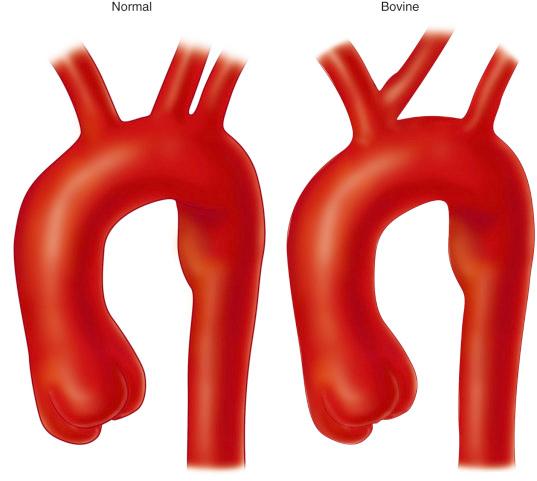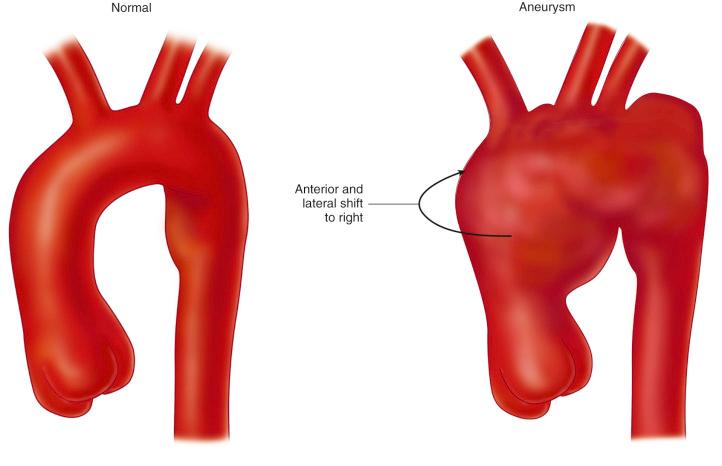Physical Address
304 North Cardinal St.
Dorchester Center, MA 02124
Academic anatomists refer to the aortic arch as that part of the aorta that begins and ends with a line drawn in cross section across the aorta at a level corresponding to the lesser curve of the aortic arch. This therefore implies that the arch of the aorta starts at approximately the level of the superior reflection of the pericardial sac. However, surgical anatomists and surgeons tend to consider the aortic arch as that portion of the aorta that begins with a line drawn in cross section across the aorta at the level of the proximal origin of the ostium of the innominate artery and ending at the distal margin of the ostium of the left subclavian artery.
The aortic arch tapers somewhat from anterior to posterior owing to the takeoff of the three large arterial branches—innominate artery, left common carotid artery, and left subclavian artery. In approximately 5% of patients, this anatomic configuration consists of a double ostium or so-called bovine aortic arch, where the innominate artery and left common carotid artery arise from a somewhat larger, but single, aortic ostium ( Fig. 25.1 ).

Other anatomic structures of importance during aortic arch surgery include the left recurrent laryngeal nerve, left phrenic nerve, and right recurrent laryngeal nerve. These become important when considering separate replacement of the branch vessels in conjunction with aortic arch surgery.
Aortic arch aneurysms seldom occur as isolated structures, but rather occur in conjunction with aneurysmal dilation of the proximal ascending aorta or distal aorta. Aneurysmal dilation often causes the aortic arch aneurysm to shift anteriorly and laterally to the right. Because most cases of aortic arch aneurysm surgery are performed through a median sternotomy, this anatomic change brings critical structures more anteriorly and may facilitate the repair ( Fig. 25.2 ).

Assessment of the patient's fitness for aortic arch replacement has multiple facets. Most importantly, the patient needs to be of an age and physical condition that would withstand a major operation such as this. A careful consideration of noncardiovascular comorbidities such as respiratory and renal disease should be undertaken because these are significant independent predictors of poor outcome.
From a cardiovascular point of view, left ventricular function and the presence or absence of significant valvular disease are important variables to consider. The presence of coronary disease does not preclude operation, but it would mandate additional coronary artery bypass procedures that would add to the length of the surgical procedure.
The presence of significant peripheral vascular disease in the carotid arteries, subclavian arteries, or femoral arteries is an important consideration in terms of determining cannulation and perfusion strategies during circulatory arrest. Similar anatomic considerations apply to the configuration of the aortic arch anatomy as far as the great vessels are concerned. A history of previous stroke or transient ischemic attacks may indicate the presence of significant cerebrovascular disease, and this must be investigated thoroughly with thin-slice computed tomography (CT) scans, magnetic resonance imaging (MRI), or cerebral angiography. A recommended standard preoperative workup for patients undergoing aortic arch replacement is shown in Box 25.1 .
Family history of aneurysm disease or connective tissue disorders
Cardiovascular risk factors
History of cerebrovascular events
History of renal or pulmonary disease
Previous operations on the vascular system
Previous cardiac surgery through sternotomy
Cardiac murmurs on auscultation
Palpable peripheral pulses
Peripheral vascular studies: carotid arteries, lower extremity arteries
Pulmonary function testing
Transthoracic echocardiography
Coronary arteriography
Thin-slice computed tomography angiogram of chest, abdomen, pelvis
Become a Clinical Tree membership for Full access and enjoy Unlimited articles
If you are a member. Log in here